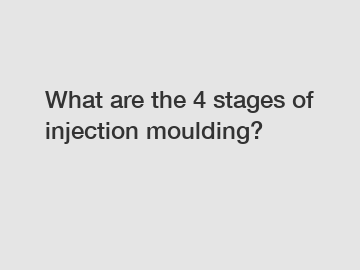What are the 4 stages of injection moulding?
Injection moulding is a widely used manufacturing process in which molten material is injected into a mould to create a product. This process is commonly used to produce plastic products, but it can also be used with other materials such as metal, glass, and rubber. .
There are four main stages in the injection moulding process: clamping, injection, cooling, and ejection. Each stage plays a crucial role in ensuring the final product meets the desired specifications and quality standards. .
The first stage of injection moulding is the clamping stage. During this stage, the two halves of the mould are securely clamped together to prevent any leakage of the molten material. The clamping force is carefully controlled to ensure the mould is tightly sealed and the product is moulded with precision. The clamping stage also helps in maintaining the shape and integrity of the mould during the injection process.

Once the mould is securely clamped, the injection stage begins. In this stage, the molten material is injected into the mould cavity under high pressure. The material is pushed into the mould through a nozzle and into the sprue, which distributes the material evenly throughout the mould cavity. The injection process must be carefully controlled to ensure the material fills the cavity completely and evenly, without any air bubbles or voids. The temperature and pressure of the material are closely monitored to achieve the desired product specifications.
After the material is injected into the mould, the cooling stage begins. During this stage, the material cools and solidifies to form the final product. The cooling time is crucial in injection moulding as it determines the quality and strength of the final product. The cooling time is determined by factors such as the material type, thickness of the product, and the design of the mould. Proper cooling is essential to prevent warping, shrinkage, or defects in the final product.
The final stage of injection moulding is the ejection stage. In this stage, the two halves of the mould are separated, and the finished product is ejected from the mould cavity. The ejection process must be carefully controlled to prevent any damage to the product or the mould. The product is then trimmed and finished to remove any excess material or imperfections. The ejection stage is crucial in ensuring the final product meets the desired specifications and quality standards.
Overall, the four stages of injection moulding are essential in producing high-quality products with precision and consistency. Each stage plays a crucial role in ensuring the final product meets the desired specifications and quality standards. By carefully controlling the clamping, injection, cooling, and ejection stages, manufacturers can produce products that are durable, reliable, and cost-effective.
In conclusion, injection moulding is a versatile and efficient manufacturing process that is used in a wide range of industries. By understanding the four stages of injection moulding and how they work together, manufacturers can produce high-quality products with precision and consistency. The clamping, injection, cooling, and ejection stages are all essential in ensuring the final product meets the desired specifications and quality standards. By mastering these stages, manufacturers can produce products that are durable, reliable, and cost-effective.
For more Rubber & Plastics Faq, Ultra High Molecular Weight Polyethylene Plastic Plate, High Quality Uhmw-Pe Fender Panel and Sill Custominformation, please contact us. We will provide professional answers.
36
0
0

Comments
All Comments (0)